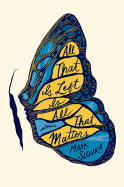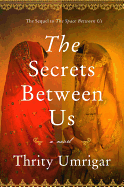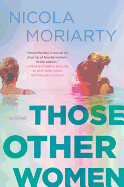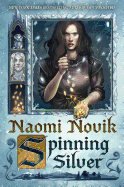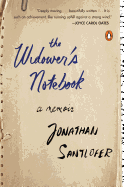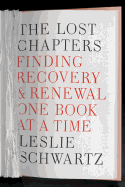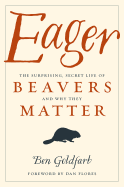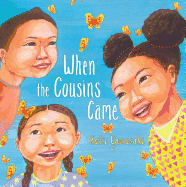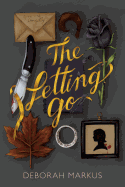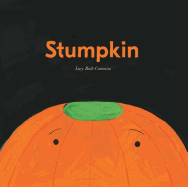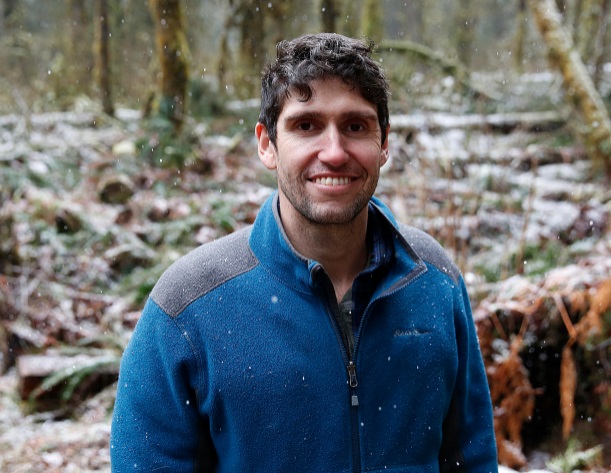 |
| photo: Terray Sylvester |
An environmental journalist, Ben Goldfarb has written for Science
, Mother Jones
, the Guardian
, Orion
, World Wildlife
magazine, Scientific America
and Yale Environment 360. In his first book, Eager: The Surprising, Secret Life of Beavers and Why They Matter
(Chelsea Green, $24.95), Goldfarb crosses North America to talk with scientists and activists about why the beaver matters--and what we can do to protect it. It's an amusing and insightful book that shows how key the beaver has been to the survival of not only other animals, but to humans as well.
Why are beavers so essential to North American ecosystems?
If you know nothing else about beavers, you're probably aware that they chew down trees, build dams and create ponds. Those ponds spread out water, fill up side channels, create marshy fringes and saturate the soil. If you were a trout, or a moose, or a wood frog, or a mallard, where would you rather live: alongside a straight, boring, featureless stream, or in a complex maze of deep pools, wet meadows, slow-water sloughs and woody islands? I'm taking that messy, diverse ecosystem every time! Water is life, and no animal captures and saves water like a beaver.
Of course, we humans rely on water, too, which means we need beavers. In Nevada, beavers are irrigating rangelands and helping ranchers feed cattle. In Washington, they're storing water to compensate for declining snowpack. In Maryland, their ponds are filtering out pollution before it can reach the sea. Beavers can even help address the opposite problem, the presence of too much water: In England and Scotland, where they've been extinct for hundreds of years, landowners are bringing them back because their ponds slow down floods. Beavers are sort of like landscape Swiss army knives--capable, in the right circumstances, of helping to tackle just about any ecological problem you can name.
What has been the biggest threat to their survival in North America?
It definitely hasn't been a great half-millennium to be a beaver! Historically, the biggest threat was the fur trade. Beavers have incredibly dense fur; they have as many individual hairs on a stamp-sized patch of skin as we have on our heads, which unfortunately means their pelts make very good hats. Beginning in the early 1600s, fur trappers wiped out untold millions of beavers for the sake of fashionable European headgear. Trapping was one of the colonies' most important industries, and the fur trade helped motivate historical events like the War of 1812 and the Louisiana Purchase. (It was also a catastrophe for Native people: white pelt traders were the source of the 19th century's worst smallpox epidemics.) For better and worse, American history would look a whole lot different without the beaver industry.
These days, the biggest threat is human conflict. Beavers, as anyone who lives near a wetland knows, can be a pain in the butt: they cut down valuable trees, flood roads and clog irrigation ditches. When beavers cause trouble, property owners usually call their local trapper to address the problem. Such "nuisance" trapping certainly isn't an existential threat like the fur trade was, but in many places it's kept beaver populations from fully recovering.
 You met a number of colorful characters while writing this book. What is it about beavers that attract such interesting people?
You met a number of colorful characters while writing this book. What is it about beavers that attract such interesting people?
You probably have to be a little eccentric to devote your time and energy to a rodent. Beavers tend to draw lots of laypeople into their orbit: some of the most dedicated "Beaver Believers" in the country are child psychologists, physicians' assistants and real estate agents. Part of the reason beavers fascinate people, I think, is that they're visible in a way that few other animals are. The average citizen will never see, say, a mink or a bobcat, but just about anyone can drive down to their local wetland and check out a colony of beavers, or at least see the animals' handiwork. Curious, passionate people make the best characters, and there's nothing like these hyperactive, social, industrious mammals to inspire passion and curiosity.
What is the status of the beaver in North America today?
Well, it depends how long your memory is. When you consider how close beavers came to extinction, they're doing spectacularly well. At the dawn of the 20th century, there were perhaps 100,000 beavers left in North America, and today there are probably something like 15 million. From that perspective, they're one of our greatest conservation success stories!
The really long view, however, is less rosy. When Europeans arrived on this continent, it contained as many as 400 million beavers; as one historian put it, "every river, brook, and rill" was chock-full of them. While beavers have returned like gangbusters to plenty of watersheds, they're still absent from many historic haunts. Beavers will never be as abundant as they once were, but we can do a lot more to welcome them back.
If there was one thing you'd want someone to take away from this book, what would it be, and why?
I hope readers come away from
Eager feeling a bit more humble about humans' place in the world. We often get wrapped up in what the writer Derrick Jensen calls "the myth of human supremacy"--the certainty that no other species can possibly match our intellect, our sentience, our power to shape the world. Yet in many ways, we're not too different from beavers: we're both creative tool-users, we both prefer to settle in river valleys, and we both modify our environment to maximize food and shelter. Aquatic rodents: they're just like us. --
Amy Brady, freelance writer and editor
Ben Goldfarb: Coexisting with a Large Rodent
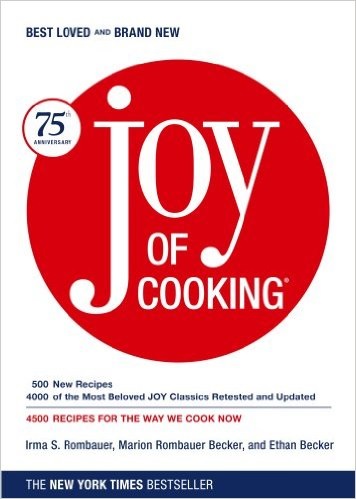 First, a nod to The Joy of Cooking (Scribner, $35), which, one could argue, revolutionized the cookbook industry in the United States (and beyond). Irma Rombauer's original edition focused on recipes that simplified steps, equipment and ingredients for doable, affordable at-home cooking. Every volume of Joy is updated; the most recent 75th-anniversary edition intentionally restored much of the voice of the original authors.
First, a nod to The Joy of Cooking (Scribner, $35), which, one could argue, revolutionized the cookbook industry in the United States (and beyond). Irma Rombauer's original edition focused on recipes that simplified steps, equipment and ingredients for doable, affordable at-home cooking. Every volume of Joy is updated; the most recent 75th-anniversary edition intentionally restored much of the voice of the original authors. Mark Bittman's How to Cook Everything (Houghton Mifflin Harcourt, $35) is exactly what it sounds like: a no-fuss, no-frills collection of recipes for, well, everything. Variations on this theme are available in his other books, including How to Cook Everything Fast (Houghton Mifflin Harcourt, $35) and How to Grill Everything (Houghton Mifflin Harcourt, $30).
Mark Bittman's How to Cook Everything (Houghton Mifflin Harcourt, $35) is exactly what it sounds like: a no-fuss, no-frills collection of recipes for, well, everything. Variations on this theme are available in his other books, including How to Cook Everything Fast (Houghton Mifflin Harcourt, $35) and How to Grill Everything (Houghton Mifflin Harcourt, $30). America's Test Kitchen is known for its thorough vetting of everything kitchen-related, be it recipe or serving spoon. Their cookbooks compile the best of their advice, as determined by their editors. In 100 Recipes: The Absolute Best Ways to Make the True Essentials (America's Test Kitchen, $40), they serve up their take on the best possible variation of every essential dish you can imagine. If 100 recipes isn't enough for you, look for Cook's Illustrated Cookbook (Cook's Illustrated, $20), an American Test Kitchen brand that offers up 2,000 (yes, 2,000) recipes from the magazine's 20-year history, all blessed by Test Kitchen staff. --Kerry McHugh, blogger at Entomology of a Bookworm
America's Test Kitchen is known for its thorough vetting of everything kitchen-related, be it recipe or serving spoon. Their cookbooks compile the best of their advice, as determined by their editors. In 100 Recipes: The Absolute Best Ways to Make the True Essentials (America's Test Kitchen, $40), they serve up their take on the best possible variation of every essential dish you can imagine. If 100 recipes isn't enough for you, look for Cook's Illustrated Cookbook (Cook's Illustrated, $20), an American Test Kitchen brand that offers up 2,000 (yes, 2,000) recipes from the magazine's 20-year history, all blessed by Test Kitchen staff. --Kerry McHugh, blogger at Entomology of a Bookworm



 You met a number of colorful characters while writing this book. What is it about beavers that attract such interesting people?
You met a number of colorful characters while writing this book. What is it about beavers that attract such interesting people?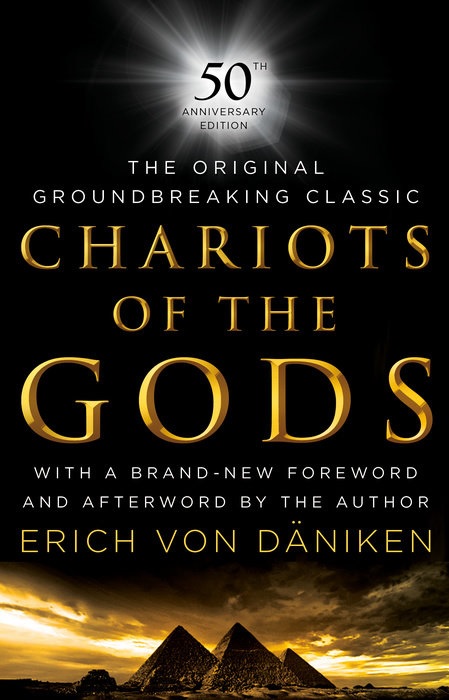 Fifty years ago this week, a book by an unknown Swiss author theorizing that aliens had established contact with humans centuries and millennia earlier was published. The book was Chariots of the Gods, in which Erich von Däniken posited that many familiar structures--such as Stonehenge, the Egyptian pyramids and the statues on Easter Island--and antique artifacts and works of art with possible images of aliens, space ships and sophisticated technology proved his point that aliens had a wide influence in ancient times. He also saw the development of religions as humans' reaction to contacts with aliens, and perhaps most striking, he theorized that present-day humans are the descendants of alien pioneers.
Fifty years ago this week, a book by an unknown Swiss author theorizing that aliens had established contact with humans centuries and millennia earlier was published. The book was Chariots of the Gods, in which Erich von Däniken posited that many familiar structures--such as Stonehenge, the Egyptian pyramids and the statues on Easter Island--and antique artifacts and works of art with possible images of aliens, space ships and sophisticated technology proved his point that aliens had a wide influence in ancient times. He also saw the development of religions as humans' reaction to contacts with aliens, and perhaps most striking, he theorized that present-day humans are the descendants of alien pioneers.